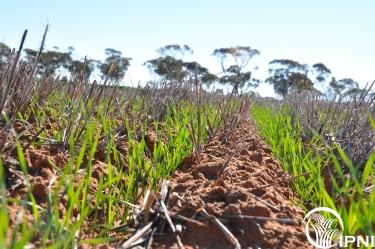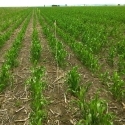18 Dec 2015
Phosphorus after the dry
Experience from the past
 Wheat crop emerging
Wheat crop emerging
Droughts are not uncommon in our farming systems. After the 2002, 2006, 2007 and 2008 droughts there have been publications to assist growers with their decisions coming into the following seasons. While there are many issues including herbicide carryover, weed burdens, subsoil moisture, crop diseases and managing cash flow, the most common question is about the opportunity to adjust fertilizer inputs especially P.
The guides developed after those events are available here, but the common themes amount them all are:
1. Grain removal is likely to be low because of the poor yields. If the crop was salvaged for hay - P was removed. Cereal hay removes around 1kg P/ha/t, while grain removes around 2.5 kg P/ha/t. Canola hay removes around 3 kg P/ha/t. In any case, knowing the P removal is important - grain P can vary from 1.8 to 4.5 kg/t - so getting grain tested will give a guide to the actual P removed.
2. Soil P tests are the starting point for any decision, but they are not likely to reflect that crop failure from the previous year, and if soil testing has been regularly done on the paddocks, expenditure on further testing may not be necessary. If not, then soil tests are needed.
3. If the soil P test is above the critical soil test value, P rates can be reduced although some P at seeding is likely to be beneficial.
4. If the soil P test is below the criticial soil test value, lower P rates can be used but yield may be affected.
5. P applied at seeding near or below the seed is the most efficient method of application, although if using MAP/DAP take care with wide rows, on susceptible soils and with sensitive crops.
6. On neutral to acid soils, much of the P applied is still likely to be available, so reduced rates are feasible.
7. On calcareous soils, P fixation can still occur even under dry conditions, so using fluid P in furrow may be a good option.
8. Where crops completely failed and the soil is in the maintenance phase, P rates can be reduced significantly.
9. There is nearly always a benefit to having some P in the seed row, and rates of 3-5 kg P/ha should be considered as the bottom line. Lower rates are likely to be less evenly distributed so give poor results.
Recropping Experiments following droughts.
After the droughts there were opportunities to assess the effects of adding "fresh" P. In the NSW DPI pamphlet there is an example of the response on barley, with low rates of seedrow P showing benefits even when there were high P rates in the drought year. This local effect is a result of poor P mobility so there is a response to having some P in the seedrow, or alternatively a penalty to not having seedrow P. We also did some trials on the Kalkee Plains after the 2006 and found the same. The results from the long-term N*P experiment at Dahlen, also show that having some seedrow P has a benefit even where soil tests are high. The effect is generally small but is statistically significant. For more details see: http://anz.ipni.net/article/ANZ-3217
If the phosphorus history of the paddock is very good, then it is possible to skip P application after a failed (drought affected) crop but if only maintenance applications are used, the crop would benefit from some P at sowing.
Additional Resources
2002 Advice - GRDCSize: 0.14 MB
2007 Advice - GRDCSize: 0.5 MB
2007 Advice - NSWDPISize: 0.06 MB
2007 Advice - Uni of AdelaideSize: 0.41 MB




